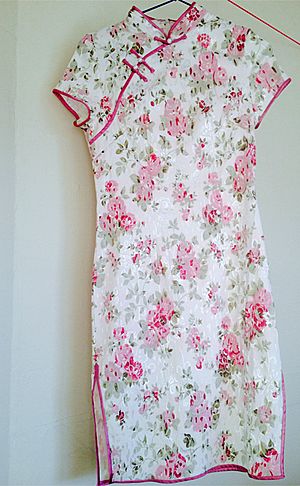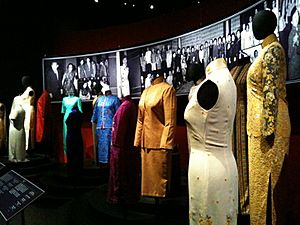Cheongsam facts for kids
The Cheongsam is a beautiful and traditional dress for Chinese women. It is also known as Qipao (pronounced "chee-pow"). This special dress often has two long cuts, called slits, on each side of the bottom part. These slits make it easier to walk and add to the dress's unique look.
Contents
How the Cheongsam Changed Over Time
The modern Cheongsam became very popular because it showed off a woman's shape nicely. It was a favorite dress for people in high society. As Western fashion changed, so did the Cheongsam. New styles appeared, like dresses with high necks and no sleeves, or sleeves shaped like bells. Some even had black lace at the bottom, like a fancy ball gown. By the 1940s, you could find Cheongsams made from many different fabrics and with all sorts of accessories.
After the Chinese Civil War in 1949, the Cheongsam became less popular in Shanghai. However, many people from Shanghai moved to Hong Kong and Taiwan. They took the Cheongsam fashion with them, and it stayed popular there. More recently, the Shanghainese Cheongsam has become popular again in Shanghai and other parts of Mainland China. Today, this style is often worn as a fancy party dress.
A Look at Chinese Dress History
In 1929, the Cheongsam was chosen by the Republic of China as one of its national dresses. In the 1930s, it was a very popular fashion in Shanghai.
Traditionally, a Cheongsam was made from silk. It was often decorated with pearls and other beautiful designs. Cheongsams fit closely to the body, showing off the wearer's shape.
From the 1950s to the 1970s, there were movements in China that went against old traditions. During the Chinese Cultural Revolution (1966-1976), the Cheongsam was seen as an old-fashioned dress. People stopped wearing it every day. If someone wore a Cheongsam, they might have been seen as supporting old ways, which was not allowed at that time. For example, in 1963, when President Liu Shaoqi visited some countries, his wife, Wang Guangmei, wore a Cheongsam. Later, during the Cultural Revolution, she faced criticism for wearing it.
Since the 1980s, people in mainland China have started to appreciate traditional Chinese culture again. The Cheongsam has become popular once more. You can see it in movies, beauty pageants, and fashion shows in China and around the world. In 1984, the People's Republic of China decided that the Cheongsam would be the formal uniform for female diplomats.
How the Cheongsam is Used Today
In the 1950s, women in the workforce in Hong Kong started wearing Cheongsams that were more practical for work. These were made from materials like wool and twill. Most were custom-made and often came with a matching jacket. These dresses blended Chinese tradition with modern styles. Over time, Cheongsams were often replaced by more comfortable clothes like sweaters, jeans, and business suits.
Because the Cheongsam can be a bit restrictive, it is now mostly worn as formal wear for important events. Sometimes, politicians and movie stars in Taiwan and Hong Kong wear them. They were also shown in some Chinese movies, like the 1960s film The World of Suzie Wong. In this movie, actress Nancy Kwan made the Cheongsam briefly popular in Western culture. However, in some Western countries, they are sometimes used as Halloween costumes. You also commonly see them in beauty contests, along with swim suits. Today, Cheongsams are usually worn daily as a uniform by people like restaurant hostesses and staff at fancy hotels.
Cheongsams as Work Uniforms
Some airlines in Mainland China and Taiwan use Cheongsams as uniforms for their female flight attendants and ground staff. Airlines like China Airlines, China Eastern Airlines, Hainan Airlines, and Xiamen Airlines use them. These Cheongsam uniforms are usually a plain color, ending just above the knee. They come with a close-fitting wool jacket of the same color. The workers wear stockings and low-heeled shoes. Their workplaces are often air-conditioned, so they stay cool.
Many waitresses in Chinese restaurants around the world wear suits and skirts. However, some still wear Cheongsams. These Cheongsams are often long, reaching the feet or floor. They have high slits, sometimes up to the waist or hip. They are usually sleeveless or have only small cap sleeves. They are often made of bright silk or satin with rich Chinese embroidery. Some nightclub waitresses, girls in special ceremonies, and contestants in Chinese beauty competitions also wear similar Cheongsam uniforms.
Images for kids
-
Chinese singer and actress Zhou Xuan wearing a cheongsam in the 1930s in Shanghai.
-
The uniform of Hainan Airlines cabin attendants, based on the cheongsam, debuted in 2017. It includes a coat worn outside.
-
A different style of qipao, seen at the Tokyo Game Show in Japan.
See also
 In Spanish: Qipao para niños
In Spanish: Qipao para niños









